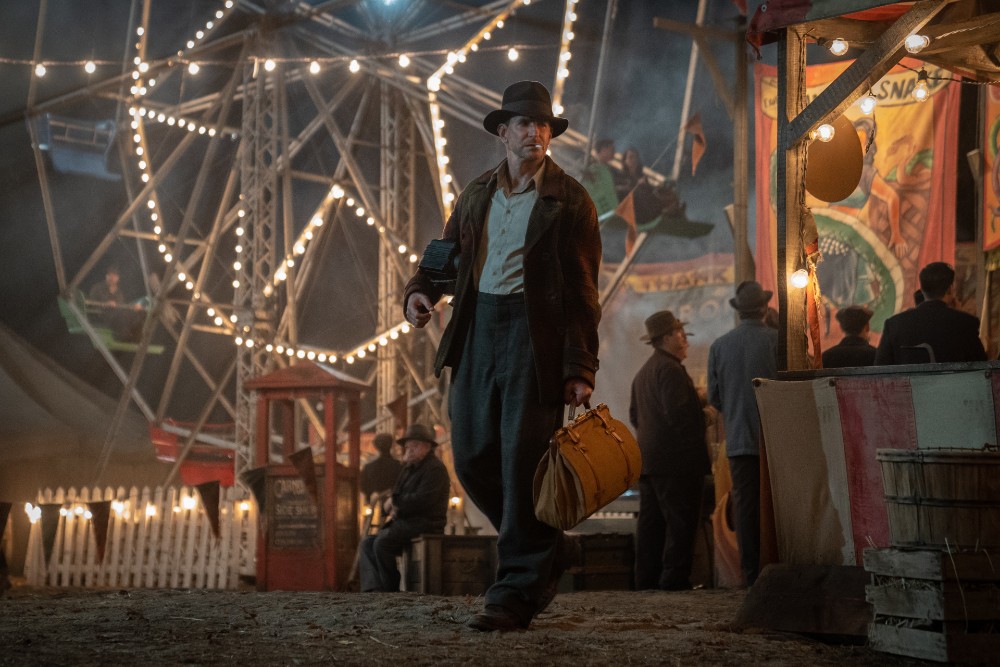
Guillermo del Toro’s noir thriller Nightmare Alley may have its DNA in the ‘40s and the original novel by William Lindsay Gresham, but it’s just as much a del Toro movie, and that means that every scene just looks absolutely fantastic with many unique locations that just pull you into the story.
The movie follows Bradley Cooper’s Stan Carlisle, a drifter who arrives at the carnival run by Clem (Willem Dafoe) and begins to learn what’s involved with putting on a clairvoyance act from Madame Zeena (Toni Collette) and her husband Pete (David Strathairn). Eventually, he goes off on his own with the carnival sweetheart Molly (Rooney Mara) as his assistant, and in the second half of the movie, he encounters Cate Blanchett’s Dr. Lilith Ritter, and the two of them hatch a plan to grift a wealthy billionaire (Richard Jenkins’ Ezra Grindle)
Production Designer Tamara Deverell, who previously worked on the del Toro-produced FX vampire series, The Strain, took on the challenge of designing and building an entire carnival for the first half of Nightmare Alley, and then creating a far more claustrophobic yet still immense art deco noir world for the second half.
Below the Line got on Zoom with Ms. Deverell the day after Nightmare Alley’s New York City premiere, where the filmmaker was practically gushing when introducing Deverell to the packed crowd.
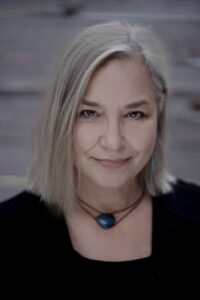
Below the Line: Guillermo was not lying when he introduced you at the premiere, because you have done some absolutely amazing work in this movie. I’ve been to a few of Guillermo’s sets, and I know he really likes to build things. He’s not a filmmaker who will just put up a green screen and tell the actors, “It’s a carnival” and then do it all in VFX.
Tamara Deverell: You know, he loves VFX — I have to say — but he wants to build it, and then VFX over it, but I love to build things, too. That’s what I’m all about.
BTL: I know you worked on The Strain, so at what point did he tell you about his interest in doing Nightmare Alley? Was this after The Shape of Water?
Deverell: It was during Shape of Water. It’s funny, because he was interested in having me do Shape of Water, but I was doing The Strain, and we couldn’t make it work. So my good friend Paul Austerberry did it, and we use the same studios, so some of the sets that we had for The Strain were actually in Shape of Water — a little sidenote, interestingly. There was a Russian restaurant, that was one of the sets that we had built for The Strain, like redressed. I’d been doing The Strain, and then I went off and did Star Trek for a while. Then one day, Guillermo and Miles [Dale, the producer] called me into this trailer. They were doing Scary Stories, and Guillermo said, “I just want you to work on some other stuff with me, okay? I don’t know what I’m doing next, but can you do it?” I said, “Yeah, you mean once you figure it out, for sure. Who doesn’t love working with Guillermo, when you’re in production design, especially?”
And then, we were gonna do this thing that I’m actually working on now, which is his Cabinet of Curiosities, which is eight curated shows for Netflix that Guillermo sort of curated these shows, and he’ll be introducing them. It’s eight different directors, eight different periods, and we’re at the tail end of it. It’s been a piece of work, though. We were going to do that, and then he sort of did really well with Shape of Water and decided he wanted to do another feature, and had been thinking about Nightmare Alley. He’d been looking at the movie, but more importantly, reading the book, because Guillermo, I think his source was really the book more than the movie, which we all watched, and I read the book. The book is very different from the original movie. So he decided to do that, and he said, “Let’s do this.” And I’m like, “Okay, I’m in. Art deco? Carnival? Wow.” It really was like working on two different movies.
We started very slowly and blissfully unaware that we were going to be totally interrupted by a pandemic, but I started working on the carnival first because we were intending to shoot that first, and it was a lot of work. We had to build all those tents, in a way building out a fabric, and we went with Armbruster, which is a company in the Midwest, that specializes in tents. It’s like a family business. They’ve been doing it since the 1890s or something, so they know everything about tents, and they do tents for all kinds of movies. They did Barnum and Bailey’s tents in the 20s and 30s. So they were the real deal. We had to do the fabric, age the fabric, do all the stuff to the fabric, get the tents going. We started the film thinking we had a lot of prep time and somebody was like, “Oh, we got to get these tents built.” So we built the tents, and we started setting them up, and then the pandemic came, and the tents… we left some of them standing. Not that many. We took down the big ones, and they were just… after stopping for six months, we just had these tattered remains floating across Ontario. [laughs]
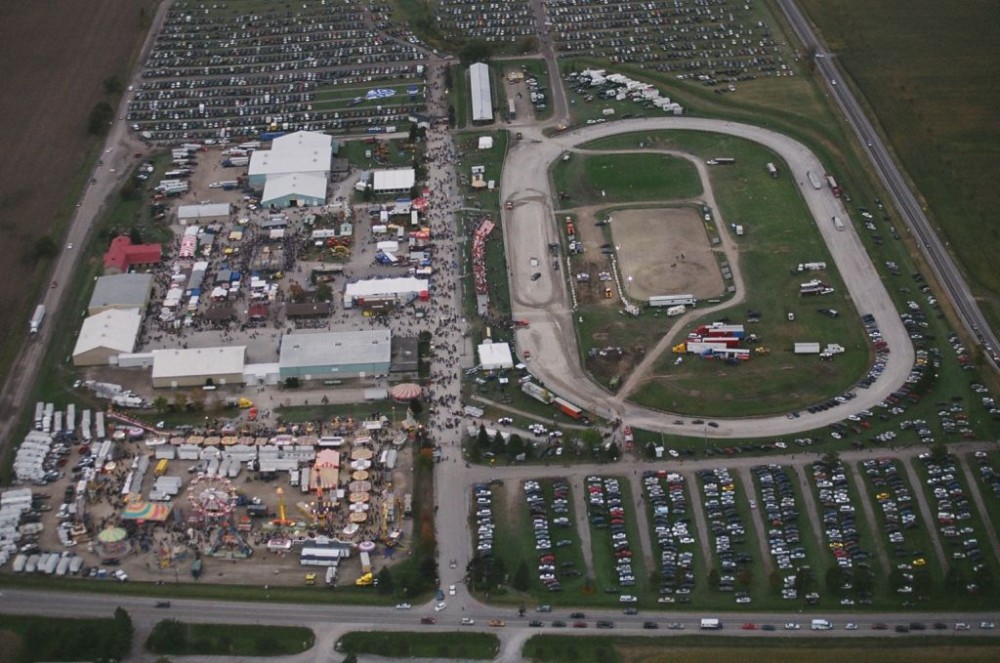
BTL: Was the carnival built on a studio backlot or was it done on a location somewhere?
Deverell: We looked at many, many different places like conservation areas where there were just big flat expanses, places that had trees around them. We looked at all these places, and finally, our location manager approached the Markham Fairgrounds, so it was actual fairground but we were on the parking lot. When the fair goes, which is once a year, they have a parking lot on a field. Basically, it was a field. It was surrounded by cornfields and other buildings, and we were able to do like the hobo camp at the end, around the corner from the carnival. Where the sheriff’s cars drive in, that was actually real. It wasn’t a VFX thing. There was a road there that we were able to use, that really worked well. But basically, it was a flat grass field where there were a few little roads through it. We just took over that field, and in fact, because of the pandemic, the agricultural festival was canceled. Because we were gonna have to shut down — it wasn’t really working out so well, but luckily, if you can think of the COVID pandemic, in terms of luck — it was canceled, and we were able to keep filming, as difficult as that was with extras and masks. The carnival was built 100%, top to bottom — everything had to be custom built. We had those crazy chalk-ware dolls in one of the games, and we actually molded all of them. The funhouse, that was a real del Toro experience, building that with a big practically moving devil and doors, and then the inside of the funhouse was actually on stage. But the inside and outside of the geek pit was part of the actual carnival, and you go in and you see the tent billowing and breathing like that, that was all real. The wind would pick up, and it was scary and annoying, but it was so beautiful, because we had this reality of the natural consequence of shooting a carnival.
BTL: Are you based in Toronto? You said you did Star Trek, which I thought filmed in Vancouver.
Deverell: No, Star Trek‘s in Toronto. There’s two Star Treks. Star Trek Discovery, that’s the one I worked on for Season One and Two, which I loved. It was terrific working on that. Great learning experience, but I’m done with sci-fi. The period thing is much more up my alley, and I don’t like to limit myself as a designer, but the Guillermo del Toro period thing, that’s all I really want in life. I don’t care about anything else. [laughs] Working on something like Nightmare Alley with all the historic aspects and then the del Toro vision of it is incredible. That was really a labor of love, Nightmare Alley.
BTL: You mentioned that you didn’t shoot at the carnival until you came back from the pandemic shutdown, so how much time did you have before that? Were you shooting on other sets?
Deverell: I think we had been shooting for six weeks. We had shot Lilith’s office, which was another real labor of love, but a very different-looking one. We shot that first. All the stuff with Cate Blanchett, we shot before the pandemic started, and in fact, we were shooting in the big Grindle’s office set. That was another stage that we built when they decided to shut down. Literally, when we came back six months later, we picked up right there where we left off. It was quite eerie, and everybody’s wearing masks, and all of a sudden, our world had shifted, but there we were in the same place. When we shut down, we were shutting down for what we thought was maybe two weeks, and the carpenters kept working, because we were behind, and we still had people building the carnival. They were out there in February and March building the carnival to be on schedule to shoot it a couple months later in the spring. And then, the studio said, “Okay, everybody make safe, lay down your tools, pack up. We don’t know when we’re coming back, but don’t worry…” And I was very worried. I actually was heartbroken. I thought the film would never be made, and all my hard work and vision and experience will just never come to fruition. And so I was very happy when we came back and started doing it.
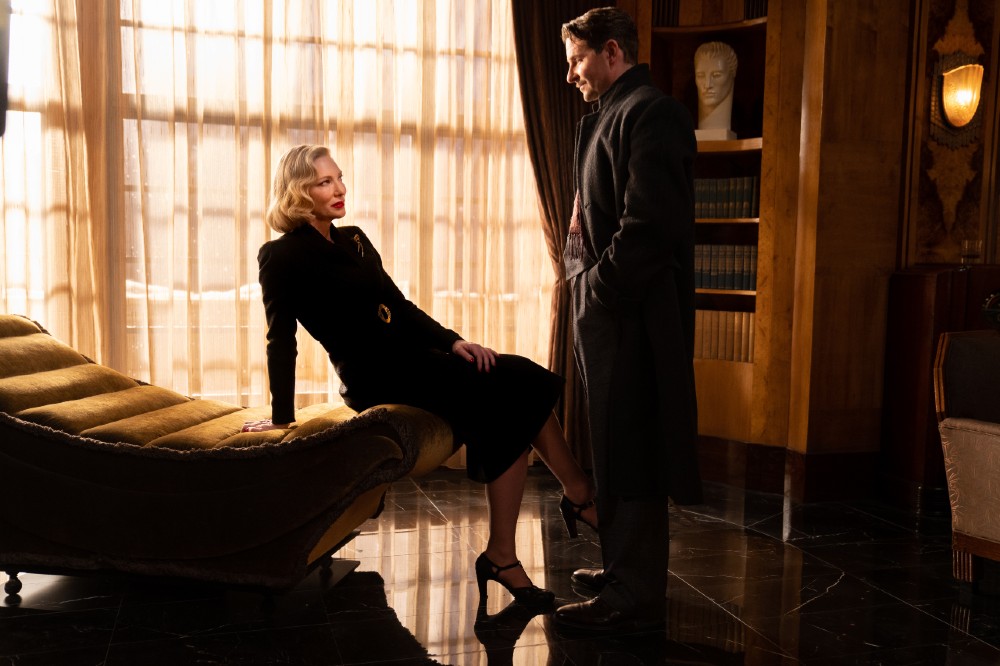
BTL: I want to ask about working with set decoration on Nightmare Alley, because there’s so much cool stuff like the tent filled with jars filled with odd objects.
Deverell: Our set decorator, Shane Vieau is incredible, but props actually did all the pickled punk jars with prosthetics. Our prosthetics team, Mike Hill and Sean Sansom, made all the little pickled punks, so we had the hero ones and we had the background ones and we had Enoch, who was a lot of specialty work. We tested the color of the liquids. We did camera tests, how amber we wanted it to be and how cloudy we wanted it to be and made them slightly different, and then we had little plexi rods holding these things, so they would float but still in position. It was a tremendous amount of work. Chris Geggie, our props master, was buying jars of different sizes and shapes to try to find period jars. We ended up having to make them. I can’t remember, I think somewhere in Mexico, we had these giant jars for the really big ones, and then we designed and built all the shelves they go on, design and built all the lighting that lights them. It was a little set, and for me, it was all about the alleyway, the lead-in to Enoch. It was one of my favorite parts, and the whole thing was [that] the geek pit was actually there right next to the pickled punks, right next to where Stan was sleeping, right next to where Clem’s tent… that was all real geography in the film, there was no cheating. You actually could walk from the geek pit up this ramp to the pickled punks, and around to Clem’s. Going to Clem’s, you’d go where we stored the bottles of alcohol, and then Clem’s tent was there, which you sort of see a smidge at the end.
BTL: I don’t get jealous often, but when the moderator of the press conference said he got to visit the set on this one, I was getting really annoyed. Let’s talk about some of the interiors in the second half. The first half is all in the carnival, but the second have is a lot of really different but all amazing locations. As a production designer, you probably have a lot of books and reference, so where do you even begin with something like Lilith’s office, for instance?
Deverell: Lilith’s office actually began for me with the art deco of it. I have lots of books and lots of references and research on art deco, but I wanted to do it in wood. When people think of art deco, they think of the Empire State Building, and they think of the Capitol Building in LA, and they think of the Buffalo buildings where we shot, and it’s a lot of bronze and marble and tile and not so much wood. To me, it’s a psychiatrist’s office, it’s a woman. I want it to be wood and powerful, but yet kind of feminine in a way.
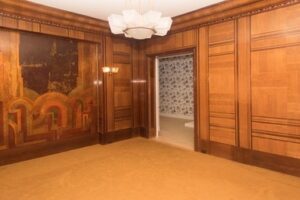
For years, I come to Brooklyn and [with] my brother, I go and we take the kids to the Brooklyn Museum, and there’s a little study in there. It’s on the floor where they have retransplanted all these little buildings. There’s this Weil-Worgelt Study, that was done by these French architects, that’s all wood veneer but art deco. That was the inspiration for me. I showed it to Guillermo. I said this little study should be Lilith’s. We should do wood veneer, and they had the Rorschachian kind of wood veneer when you split the wood and you get that Rorschach-looking thing, which just seemed like a natural to put that in Lilith’s office. Kind of creepy, very del Toro, those weird shapes. Her whole office came out of that small study in the museum. Just me looking at it for years going “I want to build something like this one day on a set.” Waiting for that moment… and Lilith’s office was that moment.
I looked at other things. There’s some things art deco, a lot of inlaid and veneer work in England. I can’t remember, but there’s some palace, a giant, special historic site. I was looking at a lot of that, and then, working with Guillermo, I had the set like this, and he’s just like “Let’s make it this big… bigger, bigger… ” It became the size of a train car from one end to the other to get the angles that they wanted and the walking and the movement and the interest, because when you’re shooting in a set like that for… I don’t know. We were there for 10 days or something, you really want every angle to be constantly of interest. There’s all kinds of intricacies with her tapes and the tape recorder that comes out [of the wall] and the safe, and then she had a little door to a bathroom, and the way in of her little entry, and then connecting that hallway. We had the back door where Stan comes in and out, and the front door where the police come at the end. All that hallway connected to the Buffalo City Hall. The city of Buffalo was amazing to us and let us take over right outside the mayor’s office. These upstairs halls where he runs, just very simple period halls, but I just loved that. We painted the halls, but that was about it, changed the lighting. But long, with this theme of an alley, everything thematically visually was about alley and elongating the spaces to move through. Even the carnival, there were alleys through the tents, so I was trying to take that theme of alleys and the characters moving through these long spaces. Even Molly’s caravan was long and narrow. The caravan at the end where he meets the guy is long and narrow. So there’s a lot of play with that.
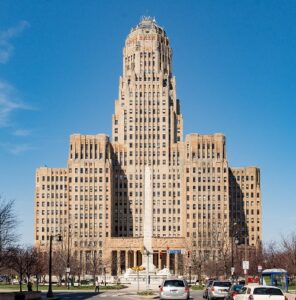
BTL: You touched upon something that interests me, because I watch a lot of movies where there are these really amazing locations that only appear in a movie for a few minutes, so I wondered about how you felt about just dressing an existing location vs. building things from scratch.
Deverell: Well, we had period locations in Buffalo, so we had the Center Circle, we had Buffalo City Hall, which is an amazing [building]. When you walk in the lobby, we had that. We had the amazing art deco building in Toronto, the RC Harris, it’s a water filtration plant as Grindle’s Factory when he drives up for a split second. Other great art deco places besides Buffalo… in Toronto, we had the CNE, which is all art deco, it’s our Canadian National Exhibition buildings that are all from the 1930s, 1940s deco period. We took that, and that was a big VFX scene where he just gets out of a taxi or his car and goes across into the Buffalo bus station. We actually took Buffalo and put it on one side of the street, so our VFX guys scanned the drive into Buffalo where it was like, “This half is Buffalo, this half is Toronto. We gotta bring those together,” which they did seamlessly. You’re watching the film, and I was like, “Oh my god, these huge, beautiful locations, you want to just soak them in,” but they’re fast — you’re in, you’re out, which is good, too, because now we’re going to watch it again and again. And then, for the Copa, the club, in Toronto, we have this incredible restored art deco club. We did a lot of building in there. Again, there’s like this circle theme — I don’t know if you notice — in the movie, so it’s a circular room, the Carlu — it’s a known venue. People get married there and have film festivals, but we loved this idea of the theme of the circle, and we built the dressing rooms that they go into with circle windows, those were on stage and the hall was on stage. But it was all part and parcel of the same architecture as the Carlu, and in the Carlu, we built this giant circular riser, so that we could bring the characters up to the ceiling. Architecturally, the Carlu was part of the art deco look.
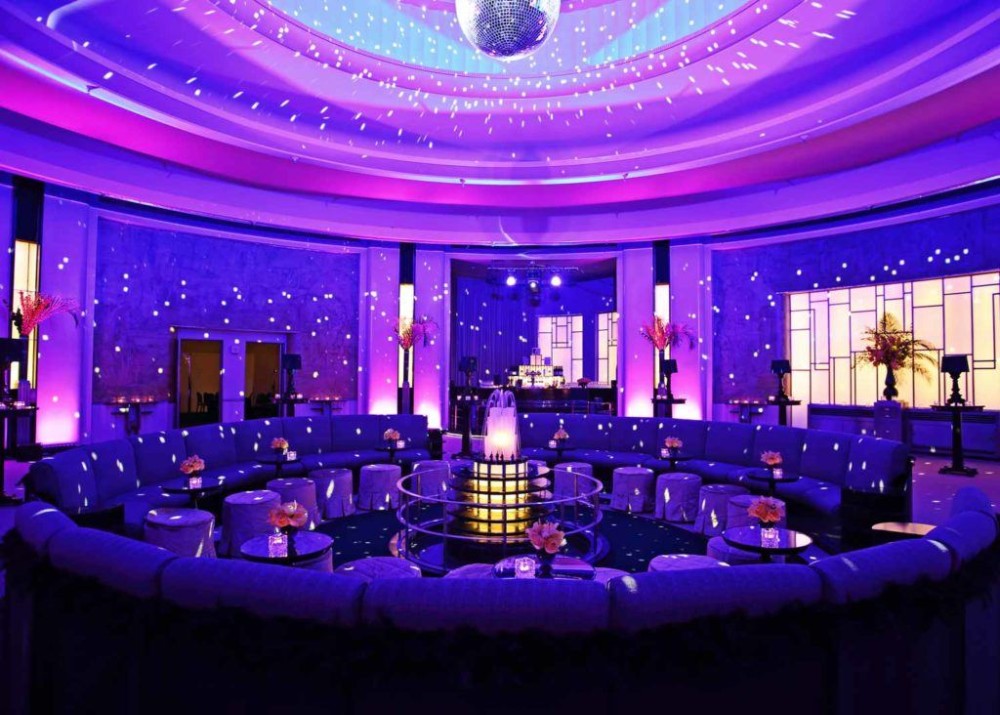
BTL: You mentioned VFX, and I wondered about your relationship with VFX and using it to enhance stuff you’ve built. Was a lot of the stuff at the carnival used to create the weather and the crowd around what you had built?
Deverell: They did a bit of sky replacement, but some of the scenes, we were really lucky with the sky. There was a couple of VFX things in the carnival, very small. Most of it was practical, but there were a couple other things Guillermo wanted to add after, a little bit of neon on Zeena’s bungalow, but those bungalows were all situated, in actuality, across from the carnival, and physically-built. So mostly for the carnival, they did a little bit of clean up, a little bit of sky, enhancing the sky, enhancing the weather. And then more, it was Elektra’s when she’s putting her [hands on the electrodes] were VFX, although it can actually look like that, but we didn’t want to do that to [Rooney Mara]. I’ve worked with Dennis [Berardi], who is our VFX supervisor pretty closely, and when I render some of the early illustrations, I always try and render in what I like to see as VFX. Guillermo always has his own ideas — he’s very involved with it. The chicken in the geek pit — obviously, we didn’t bite the head of a real chicken, so that was VFX, which was very time-consuming for them, because that’s very intricate, and a very difficult kind of thing to do. More of the anatomy of the effects were really some of the street scenes, you know,
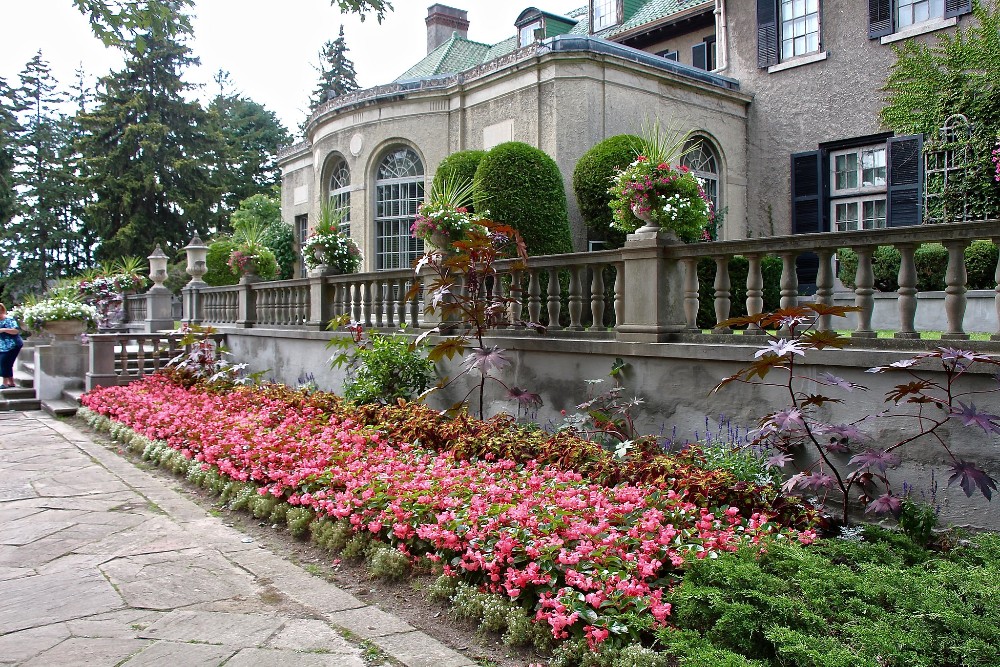
BTL: We have to wrap, but I do want to ask about the amazing maze-like garden, which I assume the snow is VFX, but you shot in Canada, so that could also be real snow.
Deverell: Some of the snow was real, but we couldn’t rely on it, because it was coming and going. So it was actually special effects, like practical effects did the snow, and they were really good, and then VFX enhanced it. Actually, speaking of themes, we actually did this swirling — you can see it around Molly when she comes in — when snow swirls around in a circular motion, VFX created that, so that was a real combination. We shot in a beautiful garden, the house that you see, Grindel’s house, was not there, but VFX scanned it. I put it there in the render, and they actually did exactly what I was hoping they would do. There is a big mansion. It’s called Parkwood Estate, and they scanned it, and they put it in that position. The whole maze of the garden, we added some greens to it that we then covered, and we did burlap wrapped around trees, which is a real Guillermo thing. And put the snow in, and we built around the sort of little portico where we built obviously the statue, this monument to Dory, the dead girl.
Nightmare Alley is still playing in theaters nationwide.
Look for more interviews with the craftspeople who helped to create del Toro’s vision soon.
All film photos courtesy Searchlight Studios; all other pictures courtesy the respective copyright holders. (Click on images for larger versions.)





